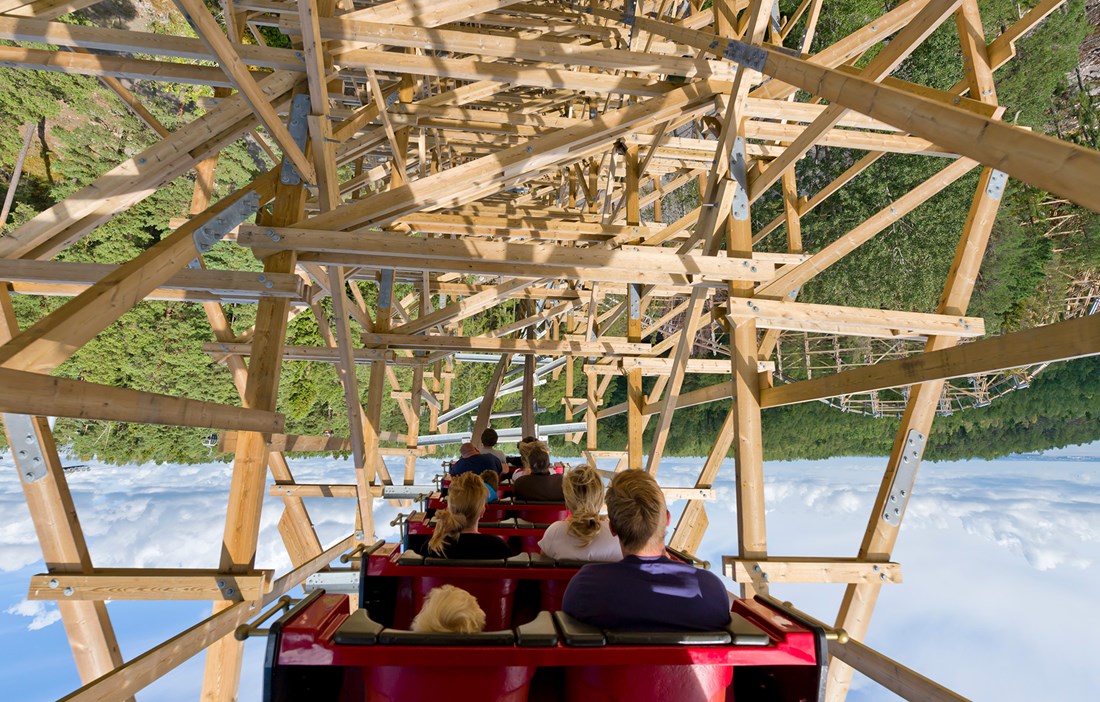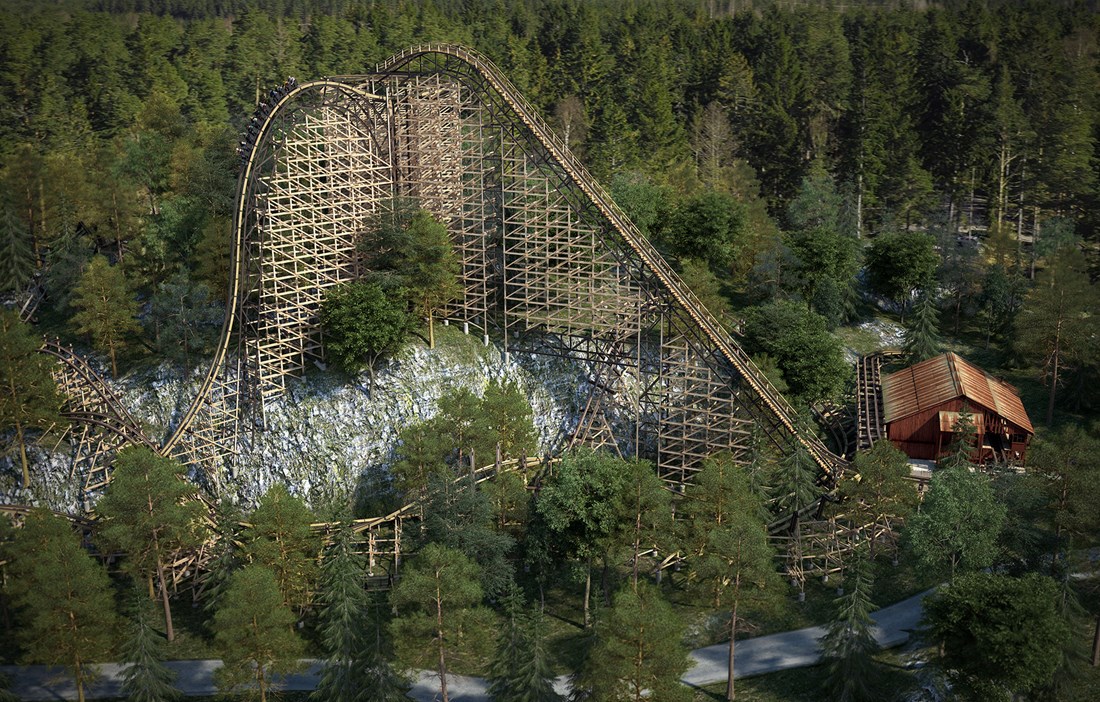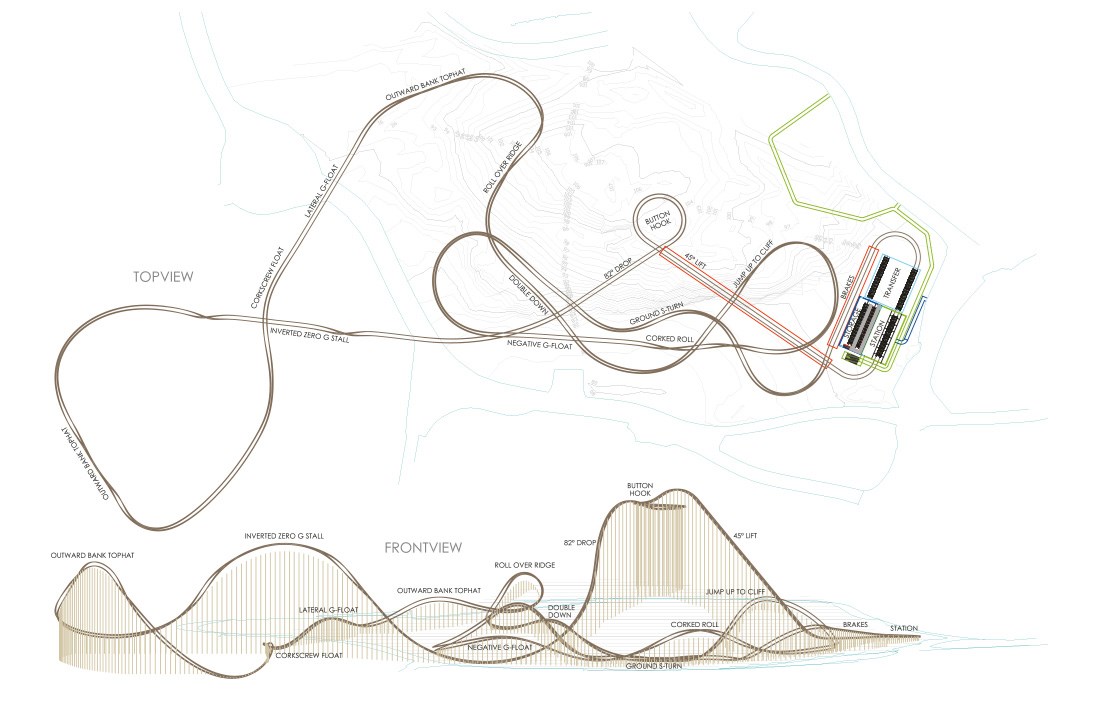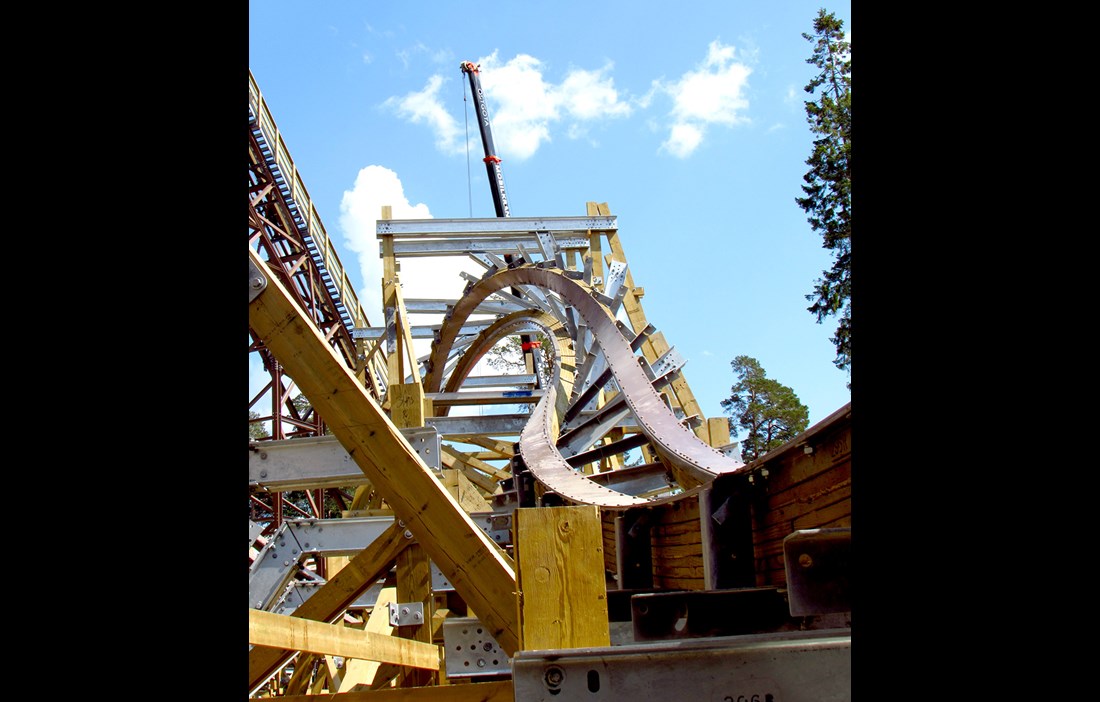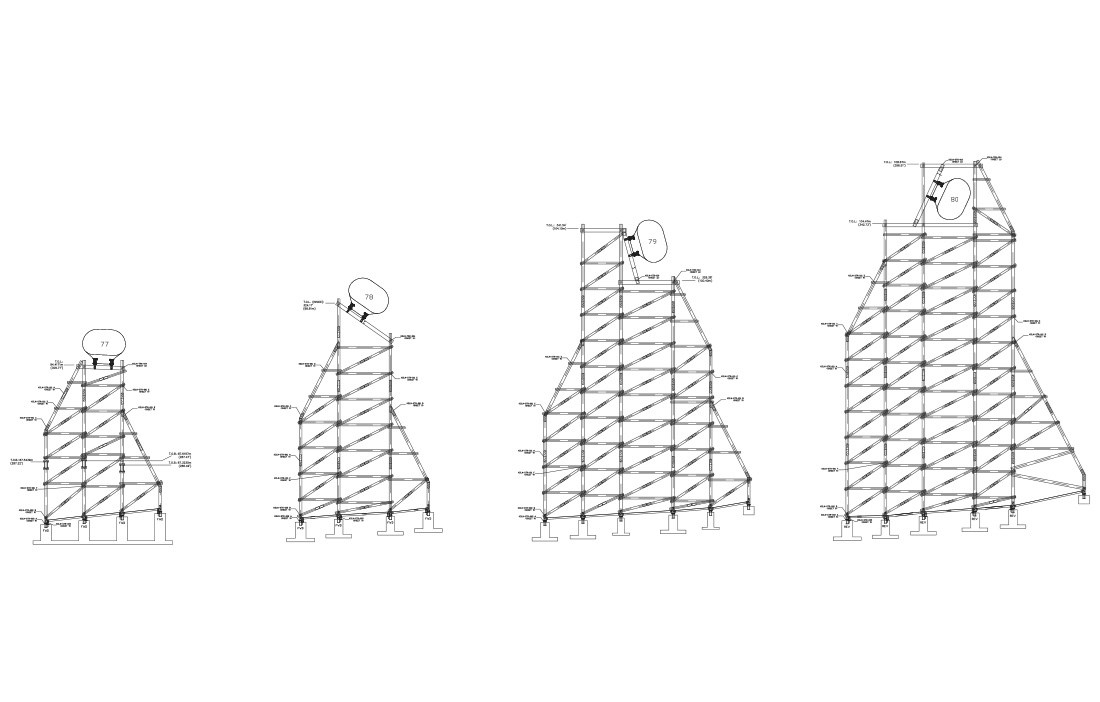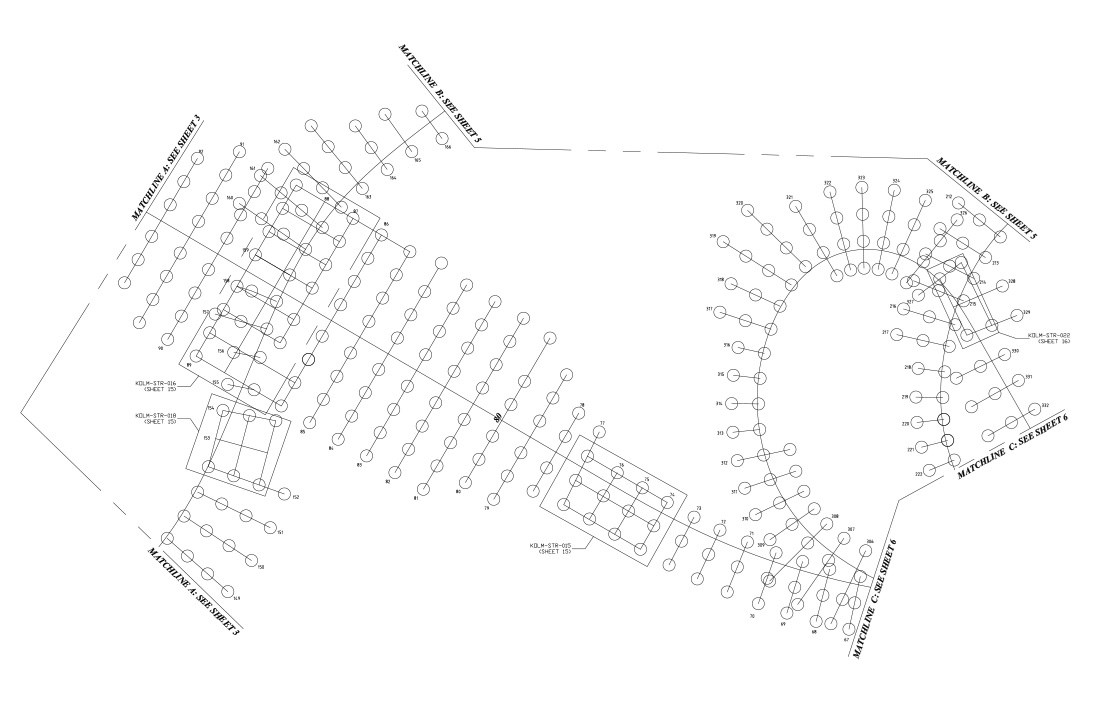The world’s oldest rollercoaster is called Leap the Dips and it is located in Altoona, Pennsylvania, USA. Since 1902 visitors to Lakemont Park have been screaming with fear and joy as the cars plunge into the dips that give the ride its name. Although how much screaming can there be with a top speed of 16 kilometres per hour? By the mid-1990s it was time for a complete overhaul of Leap the Dips. The job went to a furniture maker, since Leap the Dips is made entirely from American pine, of which two thirds was able to be preserved, despite the ride having been in service for over a hundred years.
On 28 June this year, Wildfire officially opened at Kolmården Wildlife Park. It has attracted a great deal of attention among the world’s rollercoaster enthusiasts and has one thing in common with Leap the Dips: the construction material. Otherwise, it shows just how much rollercoaster technology has advanced since the last century. The top speed is 113 kilometres per hour, and the riders have to endure a maximum drop of 49 metres and a drop angle of 83 degrees. The cars roll upside down three times during the ride.
“It was an incredibly challenging task to be involved in building one of the world’s best rollercoasters, some say the very best,” states Niklas Palmqvist, head of technology and maintenance at Kolmården Wildlife Park and project manager for the build.
With the right care, there is no reason why Wildfire can’t last at least as long as Leap the Dips, according to Niklas. For him there was only one material that Wildfire could be built in: Swedish pine.
“A wooden rollercoaster is the perfect fit for Kolmården’s natural setting. With wood from Swedish forests, it feels right historically and gives the right feel. It’s also easy to work with, we have a good supply in Sweden and the tradition of working with wood has been around for generations!”
Wildfire opened after a construction time of just over two years, and a mere two months later Niklas Palmqvist picked up the European Star Award at the amusement parks’ annual gathering, the Euro Attractions Show in Barcelona. 600 tonnes of wood were used on the build, with Swedish company Holmen supplying it all. Many of the trees were actually felled in the forests around Kolmården.
“The deliveries for Wildfire have been an inspiring and large-scale task for us, since the requirements concerning quality and strength were higher than usual. The dimensions and lengths have also been testing, since they’re based on American measurements,” commented Johan Padel, CEO of Holmen Timber, in a press release.
Fitting the rollercoaster into Kolmården’s hilly terrain was a challenge for the ride’s structural engineer and designer Alan Schilke. He is one of the world’s few rollercoaster designers and he carried out the assignment as a consultant for the American company Rocky Mountain Construction, which specialises in amusement park rides and was responsible for building Wildfire. Apart from the wooden structure, the cars and large parts of the actual rollercoaster ride were manufactured in their own factory in Hayden, Idaho. Alan Schilke placed the highest point of the ride on a partially forested rocky outcrop, which puts the riders 135 metres above the waters of Bråviken bay before plunging down again. The whole rollercoaster blasts its way through the trees and here and there a loop rises up above the pines.
Wildfire was built using Rocky Mountain Construction’s own patented system for both the cars and the wooden structure. It is held up by solid vertical posts measuring 4 x 8 inches (100 x 200 millimetres) that are anchored to the ground on cast concrete foundations. The spaces between the posts are 8 feet 10 5/8 inches, about 2.7 metres. Between them, timbers are fitted both horizontally and diagonally, absorbing the acceleration forces that reach a g-force of up to 3.75 as the cars thunder through the tight curves with their 24 passengers. The timber is joined along its length using steel plates. Everything is held together with 130,000 bolts, secured with steel locking nuts. This means the thread on one end is slightly deformed, which causes the nuts to lock in place. But actually building a rollercoaster is in some ways less demanding than building a house, according to Niklas Palmqvist.
“For example, a house has to keep the cold at bay, it needs ventilation and so on. This rollercoaster is only used for a short part of the year, plus it contains masses of standardised structural solutions, and the same technique is used along the whole ride. The heights are, however, a challenge and there is a great deal of climbing and manual work up in the air!”
The wood that Rocky Mountain Construction recommends and usually uses is southern yellow pine, a quality pine that grows in the southern USA. The company took some convincing to accept Swedish pine instead – but after some intense correspondence across the Atlantic, the American builders were persuaded that slow-growing pine from Kolmården and Hälsingland offers the same density as the American wood. All the wood used on the build achieves the extremely high strength grade of C35. To reassure the builders that all the wood was of a sufficiently good quality, all the logs were x-rayed before being sawn up at Iggesund Sawmill.
“The focus was on finding the right correlation between strength, density, knot size and width of growth rings,” explains Niklas Palmqvist.
The width of the ride’s track is 3 feet 10 5/8 inches, which is about 1.2 metres. The only things not made from Swedish pine are the rails, the substructure for the rails and the lift hill, the mechanism that pulls the cars up to the top before they are sent hurtling down the other side. The track is so wide that steel had to be used to keep the dimensions down. The substructure for the rails is made of Laminated Veneer Lumber in American red pine, which is shaped into the ride’s curved forms.
Wildfire’s overall height is 57 metres and it is 1,300 metres long, which will take visitors two minutes to scream their way through. The noise has actually been a complex factor in the process – an appeal against the planning permission had to go through the Land and Environment Court before the first ground could be broken. But the fact is that a wooden rollercoaster is significantly quieter than a steel one, says Niklas Palmqvist. The wood absorbs vibrations and noise, and to keep the decibel level even lower, the steel rails that the cars roll on have been made hollow and filled with concrete. This makes the rails quieter and improves the stability of the structure.
All the wood is pressure treated (NTR A) to tolerate prolonged exposure to the elements. However, the operation of Wildfire comes with an extensive maintenance programme and numerous checklists. All wood moves and to make sure the 130,000 bolts don’t start rattling, they are inspected regularly and the more stress the different parts are under, the more often they are checked.
“Every day that the ride is open to guests there is a morning routine that involves climbing to selected sections of the structure according to a specific timetable and checking and adjusting the bolts.”
At the time of writing, the Land and Environmental Court has submitted its judgement that a detailed development plan is needed for Wildfire. Kolmården Wildlife Park and the local municipality are currently discussing how this situation can be resolved.

